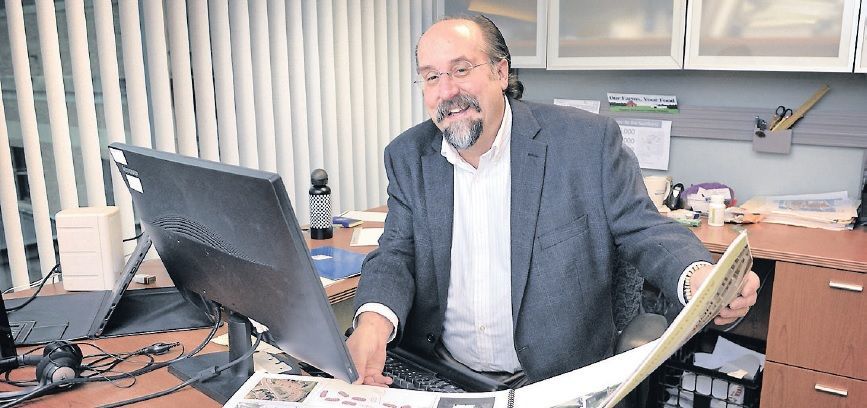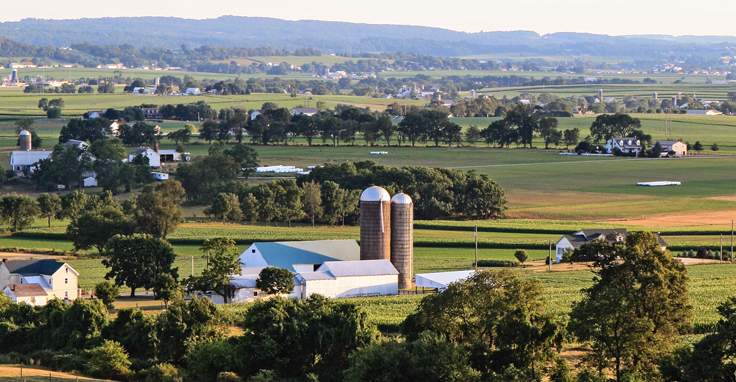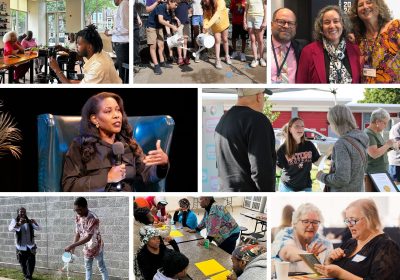As we expand our work in civic engagement and humanities-based community development, PHC staff have built strong partnerships with like-minded organizations, including the Pennsylvania Chapter of the American Planning Association.
We were recently able to catch up with James Cowhey, the president of the Pennsylvania chapter, to talk about the importance of engaging residents in community planning and how the humanities can inspire change in communities. Cowhey is also executive director of the Lancaster County Planning Commission.

What intrigues you about community planning? Why did you choose/ how did you enter the field?
The goal of a planner is to help a community think about changes that are occurring that determine the future of the community. Planners help a community articulate its aspirations for the built and natural environments and how to manage change in a way that delivers a prosperous future and a better quality of life. The change that is occurring, like whether population is increasing or decreasing or business is thriving or not, is constant. Planners can analyze the data and information about changing conditions and help a community outline choices for action that will result in the desired future for its citizens. I’m intrigued by the uniqueness of each community and how planners provide plans that fit to each situation in a way that helps to ensure implementation.
I entered the field of planning with an undergraduate degree in geography. For me, there was an obvious link between the study of human activity on the earth and the phenomenon of how people plan the physical settlement of places they inhabit. The discipline of urban planning exists at the intersection of geography, engineering, architecture, landscape architecture, law, politics, ecology, economics, social studies, and other professions and disciplines. It never ceases to be interesting because planning is about the built and natural environment and such a variety of other aspects.
Why is community engagement important in community planning processes?
While experts can analyze data and provided policy choices for consideration, community planning in a democratic republic must be based on citizen participation. Inclusive planning processes ensure that the data is considered within the context of citizen thoughts, ideals, and aspirations. Citizen participation in community planning efforts is a fundamental way to participate in local democracy. Consensus is the goal. Consensus is brought about by elected officials of a community. Consensus is found by considering the multitude of views and elected officials using their judgement to adopt a plan that will provide the most good for the most individuals. Citizens have a fundamental right to participate in planning for their future.

How do you go about engaging residents whose voices are not heard/ those who are usually not a part of the planning/decision making processes?
Engaging disenfranchised or disinterested people is a vexing problem for planners. The engagement program of a plan must provide a variety of opportunities and venues so citizens can choose where and when to interact with planners and other residents. People have different needs and are more comfortable with some ways of interacting than others. We use public meetings, small group meetings, internet surveys, websites, written survey forms, etc. to connect citizens to the plan. We make specific outreach efforts to certain groups in an effort to provide them with a means to interact with the process. For example, we work with the Spanish American Civic Association to assist with outreach to the Latino community. We have contacts with the Old Order Amish Steering Committee that provides an opportunity to discuss planning issues with that group. Web access and social media has broadened the opportunities for interaction but has not replaced good, old fashion community and small group meetings.
This past spring Lancaster Farmland Trust released results of a public survey about Lancaster County residents’ opinions on farmland preservation and policies. How will these results (the opinion of the residents) help to make change?
The Lancaster Farmland Trust is strong partner in Lancaster County’s planning efforts as are several other countywide interest groups. The survey information, plus additional feedback from LFT, will be part of the background information considered for our new plan called Places2040. As part of this latest effort we have established our Partners for Place which is an alliance of about 18 countywide groups that play some role in thinking about and acting on the future of Lancaster County. These groups represent a range of interest groups: realtors, builders, agricultural preservationists, smart growth advocates, environmentalists, housing advocates, economic developers, business advocates, historic preservationists, and others. Each organization has a unique perspective and plays a distinct role in shaping the future of Lancaster County. Their participation, combined with the input from individuals, will be reflected in the adopted plan making sure it expresses the aspirations of our community. This will be the foundation for future action to implement the plan. Implementation will not simply be a county government role but job for individuals and organizations.
What partnerships have you built as the executive director of Lancaster County Planning Commission?
I believe strongly that a community that is not providing opportunity to generate wealth by providing opportunities for investment by business and job growth for individuals will not thrive. I’ve worked to strengthen the linkage of our work with that of the Lancaster Chamber of Commerce and Industry, the Economic Development Company of Lancaster County, the Lancaster County Agriculture Council, the Lancaster Housing Opportunity Partnership, the Lancaster County Redevelopment Authority, and the Lancaster City Alliance. Our partnership with Lancaster General Health/Penn Medicine is an equally important partnership that links planning for the physical livability of the county to opportunities for active lifestyles and healthier outcomes.

Why is it important to build these partnerships and relationships?
These groups recognize that a well thought out plan for the future is a foundation that helps to secure investment in new businesses and housing, and redevelopment of existing communities. A strong local economy will allow us to deliver the quality of life and built environment our citizens want and deserve. Economic development and regional planning are mutually reinforcing activities. The linkage between health and the built environment is an emerging planning issue that allows potential health outcomes to be part of planning for the future of the community. Walking and bicycling, for example, are transportation alternatives that have often been missed opportunities in community planning. However, we know that these active transportation modes are enjoyed by residents and can help people be healthier.
Can you give me an example of when the planning department partnered with another organization to solve an issue?
The lack of housing at affordable rents or purchase prices is a critical issue in Lancaster County and will be for some time to come. Over twenty years ago the Lancaster County Planning Commission along with other partners helped to found the Lancaster Housing Opportunity Partnership (LHOP) as a means to raise awareness about housing cost burdens for a large part of our community. Additionally, LHOP instituted programs that provided information and training that helped families and individuals find housing they could afford to buy or rent. LHOP has grown to be an exemplar of what a community housing organization can and should be. They have trained people how to be good renters, how to prepare their finances in order to buy their first home, and in the past several years have actually begun to redevelop older units to be re-inhabited at affordable purchase prices. As planners we deal mostly with the locational aspects of housing.
Our partnership with LHOP adds a housing program service dimension in the community that deals with a vexing part of the shelter issue that planners are not given direct authority to fix. Recently, we worked with LHOP on a countywide housing market analysis that indicates that there are obstacles to allowing the market to deliver a range of housing options by unit type and price. There are no simple solutions but we are concerned that our future prosperity is threatened by our inability to provide housing that is affordable across the income spectrum. This partnership has raised awareness of the issue and begun to actively address them.

How can the humanities inspire change in communities?
Urban design principles have developed over thousands of years of human civilizations and are a result of environment, geography, culture, economy and history. At its best, urban and regional planning is an interdisciplinary exercise which may, but doesn’t always, include the humanities directly in the process. A study of the humanities informs the way we improve the physical environment we inhabit by pointing the way to improving social interactions and “livability” or quality of place.
I think planners have to understand the history and culture of the place where they are working in order to truly elicit the vision and aspirations of the people. It’s been said that to understand where you want to go, you must understand where you are at the moment and where you came from. That is as true for community planning as for anything else. Understanding through history, architecture, and the arts how a place was settled or came to be reveals much about what a community is at present. Art and literature can help a community better imagine what it can be by providing a means of envisioning the future. Photography, videography, and storytelling are often used by planners to illustrate to community members what is, but also what can be.
Recently, in a series of meetings about a new plan for the county, we asked residents to share their stories about why they believe Lancaster County is a special place. They told us stories about their childhood memories and experiences, about their observations of the changing landscape, or about what motivated them to move to the county from somewhere else. These stories affirmed the sense of place that the audience felt and helped the planners ground the plan in the citizens’ ideas about the community.

![[color – dark bg] PA SHARP FINAL FILES DB 72dpi [color - dark bg] PA SHARP FINAL FILES DB 72dpi](https://pahumanities.org/uploads/files/elementor/thumbs/color-dark-bg-PA-SHARP-FINAL-FILES-DB-72dpi-phgl7aimtfdpzt2rscvl43ksfv3asbbls19lsvuacw.jpg)


